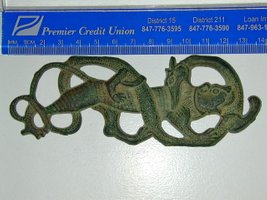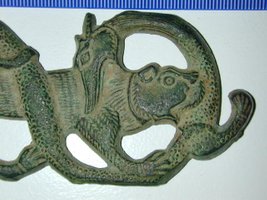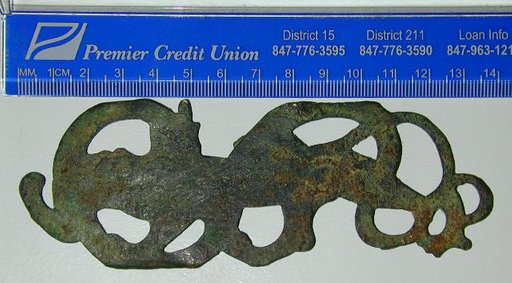Is It Viking ? The familiar and ever returning question among Viking-Age artefacts collectors.
This week's blog - from yours truly himself this time - is putting the spot on the among Viking-Age artefacts collectors ever thrilling, amusing and tantalizing question when shown an artefact they cannot address: 'Is It Real ?'
In fact dear Viking-Age artefacts belovers, one could write once a week a blog like this. But I will restrict myself to this weeks Mystery Object or described in other words: Loch Ness being bited by a cat like animal and biting it back.
Let us amuse ourselves, and at last get tantalized...
One fine day in the beginning of Spring, a good friend of mine on the other side of the ocean, sended me diverse pictures of this by him called 'brooch'. Of course the kind of interlace triggered me to define this artistically vikingishwise as 'Late Viking', but I couldn't put my hand on it..
The object, being found in England was rather too sharp in detail and execution to be really from the Viking Age, as many items found there suffers and suffered from the bad soil condition and debased metal quality used in Anglo-Scandinavian areas involved. The crispiness of the piece I found remarkable, and made me place it somewhat further in the Middle Ages.
After a day or two dubbing I came with the definition: 'Late Urnes transverse Romanesque Style', 1150 - 1250 (more to 1250 than to 1150 A.D.) where James Graham-Campbell when consulted seemed to agree on. But the ever remaining question popped up..
"Where can I find a reference, is there a similar artefact to be found in literature ?"
Now: not always is this the case, and in defining an artefact as being Viking-Age one has to have the knowledge how an Viking-Age artefact should look like.
Sometimes the artefact is representing one of the distinct Viking art styles (like Borre, Urnes etc.). Sometimes it doesn't, though one can define the distinct vikingness of the execution of the piece nevertheless.
The biting and interlacing curling of animals kan be found in Romanesque churches, like the one I have visited in Münster, Germany last winter. These (phantasy) animals are biting into plant tendrils, or themselves. But always one direction, without being bitten backwards.. like the piece in this week's blog involved.
Then the idea popped up, after consulting my 'Ring of Expertise' (wich most of them rejecting the idea that this was viking), to put a call on Facebook on diverse metal detecting forums in Holland.
Now, and this is very dissatisfying, in Holland there seems to be very little or no people heavily experted on Viking-Age objects on social media or otherwise. So, after the good laughter and jokes around, someone even came up (very firmly) stating that this was a 'Victorian age snake brooch'.
As I was very surprised by this firmly addressed statement, I googled 'Victorian snake brooches' and simultaniously consulted Martijn Akkerman, a in Holland well known jewellry specialist from the tv-programme 'Tussen Kunst en Kitsch' (our own 'Antiques Road Show' in Holland).
http://web.avrotros.nl/tussenkunstenkitsch/experts/martijn_akkerman.aspx
The 'Victorian snake brooches' turned out to be an absolutely no go.
Being eloborate, in shiny silver and gold, often set with garnments and more or less precious stones, the snake and cat brooch just casted in bronze was a world away from this..
See link
Then I received the reply from Martijn Akkerman
'The mount absolutely doesn't has its origin in the 19th century en cannot be compared with the type of snakes casted on jewellry from that period of time. My first impression is of an earlier time, and possibly indeed Viking-Age. In my opnion, a 19th century age of the piece can be forgotten, wich might make it a little easier determing it'.
So, my dear beloved Viking-Age crazy researchers, collectors and lovers.. where does this all lead to ?
As always: Mystery. Some mystery, wich we cannot live without I guess. The answer lying in the dark Mist of Evermore. Or is it 'Battle of Evermore' ?
As it is..
If any thoughts on this piece of art (wich, old or newer, I think it is) please be invited to let me know !
Yours truly,
Thomas Kamphuis, April 24th 2015.
Link to blog April 5th 2015.
Well. I could have been with these stones until after dark, but as my wife wanted to travel on.. well.. I see you again, some day, hogback stones from Gosforth. And if you happen to be there one day, do not forget that monument on the outside...
Further on with the Cumbrian hogbacktour !
In - yes, luckily again in - St. Peter's church in Heysham, there is a truly beautiful hogback stone. The guide told us, it had been studyied by Thor Ewing, a writer, in 2000. in 'Understanding the Heysham hogback' A tenth century sculpted stone monument and its context (link), Thor Ewing tells in detail what he dicovered on the both sides of this hogback stone.
Just being brought in the church as late as the 1970's accompanied with some protest here and there among the church visitors, considered as being a token of old paganism, it had been remarkably nice preserved, and a lot of detail can be seen, still. Truly worthwile a visit.
I had a small debate with the guide in the church if the - zoomorphic, in my opinion - faces on the sides were lions (or hippo's). The guide doubted if the vikings could have known about lions. Well I guess so, concerning the runes on the Ancient Greek lion statue at the Arsenal, Venice. For example. Vikings did travel south..
But when he told me he was doubting the vikings 'discovered' (as the native inhabitants were of course, in the first place) America before Columbus, I decided to rest my case..
One has to know when to start and to end a conversation ..
Just discovered the book in a bookstore written by Geoff Holder - The guide to the mysterious Lake District, I knew there had to be another hogback stone in Lowther, St. Micheal's Church. With a promising image described in the text of 'a naval and a land-based force of shield-bearing vikings above a fish and what might be a coiled sea serpent. On the reverse is a row of female figures with snakes, possibly a representation of the hideous hag Hel'. Wow. If that did not sound as a true pagan promised land ..
Not complaing too much after all we have seen, this visit was the dissapointing one of them all. But if you wife states 'I am happy to have seen them' and I am answering 'Measuring is knowing' and the even more obligate verb 'handling 'if we did not see it at all, we wouldn't have known anything at all of how they were looking' the glass was again half full, at the last day of our journey..
The hogback stone appeared to be just being tolerated within the entrance segment part of the church. As something you never use anymore but you do not throw away - entirely. That sort of feeling emerged when seeing this hogback asylum seekers.. Bed, bath and bread, ás we say in Dutch, but no luxury at all and standing on some outcuts of wood, you would balance the table with at home..
Come on, St. Micheal's Church.. care a bit more of your 'children' !
This hogback stone was moved in the church in 1907. Hogback stones layed partially buried in the churchyard before it was dug up and moved into the church.
The promising depiction of a longship - as certainly can be seen after some studying - see http://vikingminds.co.uk/pages/longship
we have missed !
The stone itself is (157 x 50 x 30 cm) and very worn.
The hogback stones in Cumbria - very diverse in quality, but everyone worth a visit ! Especially on a gloomy day in late October ...
The churches to visit - see photos of resp. St. Andrew's church in Penrith, St. Mary's church in Gosforth, St. Peter's church in Heysham and St. Micheal's church in Lowther.
Did I miss out on another one in Cumbria ? Let me know !
In a next blog I will take you to four - still remaining utterly mysterious- statues 'guarding' the graveyard of St. Andrew's church in Dacre..
For the last blog of October 9th see this link.
References: (as always, links to where the books can be ordered are attached).
Edwards, B.J.N. Vikings in North West England - The artifacts (1998);
Emery, Gordon, CURIOUS CUMBRIA, The Lake District & Beyond: A celebration of Cumbria (2023)
Ewing, T. 'Understanding the Heysham hogback' A tenth century sculpted stone monument and its context ;
Hall, R. Viking Age archaeology in Britain and Ireland (first printed 1990, reprinted with amendments in 1995);
Holder, G. The guide to the mysterious Lake District (2009)
possibly also (as there within the part of Cumbria dealing with Carlisle, the Eden Valley, Barrow-in-Furness, Whitehaven and the west coast is being dealed with)
Holder, G. Paranormal Cumbria (2010)
http://vikingminds.co.uk/pages/longship


